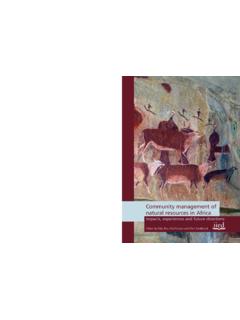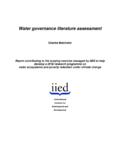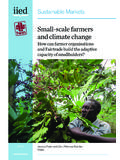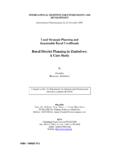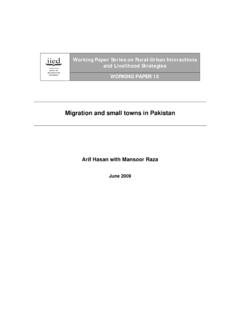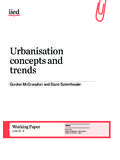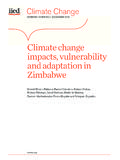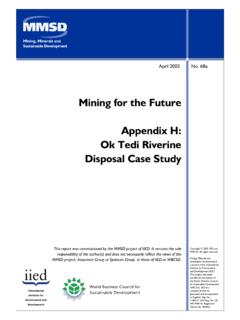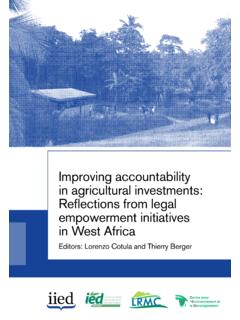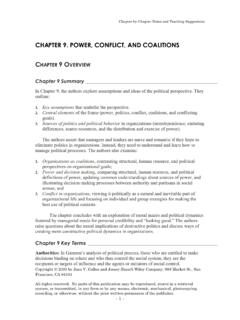Transcription of Development finance and climate finance - pubs.iied.org
1 Development finance and climate finance Achieving zero poverty and zero emissions Paul Steele Discussion Paper climate change Keywords: April 2015 finance , Adaptation, Mitigation About the author Paul Steele is chief economist at IIED. His focus is on financing for the Sustainable Development Goals and incentives for an inclusive, green economy. He spent eight years with the United Nations Development Programme (UNDP) in Bangkok working with ministries of finance in Asia Pacific on climate and environment issues and four years with the Department for International Development (DfID) in London working on poverty and environment issues.
2 Email: Produced by IIED's Sustainable Markets Group The Sustainable Markets Group drives IIED's efforts to ensure that markets contribute to positive social, environmental and economic outcomes. The group brings together IIED's work on market governance, business models, market failure, consumption, investment and the economics of climate change. Acknowledgements The author wishes to acknowledge comments and discussions with Simon Anderson and Saleemul Huq at IIED, Jan Corfee- Morlot, Stephanie Ockenden and Hildegard Lingnau at the Organisation for Economic Cooperation and Development (OECD), Romilly Greenhill and Gideon Rabinowitz at the Overseas Development Institute (ODI), Aaron Atteridge at the Stockholm Environment Institute (SEI), Shari Spiegel at the United Nations Department of Economic and Social Affairs (UNDESA), Gail Hurley at the United Nations Development Programme (UNDP) and Manish Bapna at the World Resources Institute (WRI).
3 Any errors are the responsibility of the author and the views expressed in this chapter are the author's own and do not necessarily represent those of these individuals and organisations. Published by IIED, April 2015. Paul Steele. 2015. Development finance and climate finance : Achieving zero poverty and zero emissions. IIED Discussion Paper. IIED, London. ISBN 978-1-78431-169-8. Printed on recycled paper with vegetable-based inks. International Institute for Environment and Development 80-86 Gray's Inn Road, London WC1X 8NH, UK. Tel: +44 (0)20 3463 7399. Fax: +44 (0)20 3514 9055. email: @iied Download more publications at IIED Discussion paper The relationship between Development finance and climate finance is a key political issue.
4 Some (particularly least developed country (LDC). climate negotiators) stress the differences. Others (most bilateral Development agencies). stress the similarities. But understanding this relationship has now become urgent. We must distinguish between different types of international climate finance (adaptation and mitigation) and recipients of these funds (LDCs versus middle- income countries). In LDCs, links between adaptation finance and Development finance are strong and so this should be counted as official Development assistance (ODA). But in middle- income countries, links between mitigation finance and Development finance are weak, so instead this should be additional to ODA and counted as the new metric of total official support for sustainable Development (TOSD).
5 3. Development finance and climate finance | Achieving zero poverty and zero emissions Contents List of figures, boxes and tables 5. Acronyms 6. Summary 7. 1 Development finance or climate finance ? 9. 2 Is mitigation finance crowding out poverty reduction? 12. 3 Development finance is still urgently needed 16. 4 Why the best climate adaptation is resilient poverty reduction 18. 5 Why climate mitigation finance in MICs should be additional to ODA 20. 6 Domestic private finance : driving mitigation, saving money 22. 7 Incentives for developed countries to spend on mitigation in MICs 24. 8 Country systems for climate finance 26.
6 Conclusions 28. Notes 29. 4 IIED Discussion paper List of figures, boxes and tables Figure 1. Comparing MICs mitigation finance with LDCs total Development finance 7. Figure 2. climate finance compass: adaptation, mitigation, LDCs and MICs 11. Figure 3. Multilateral and bilateral climate aid in 2013 13. Figure 4. Trend in bilateral climate -related ODA, three-year annual averages 14. Figure 5. Grants and loans, principal objectives and significant objectives 14. Figure 6. Income groups receiving mitigation-related aid versus adaptation-related aid 15. Figure 7. Mitigation-related aid by sector 15. Figure 8.
7 Adaptation-related aid by sector 19. Box 1. Principal and significant Rio markers for climate mitigation and climate adaptation 10. Box 2. Total official support for sustainable Development (TOSD) 21. Table 1. 2013 renewable investments (by asset finance ) 23. 5. Development finance and climate finance | Achieving zero poverty and zero emissions Acronyms CDM Clean Development Mechanism DAC Development Assistance Committee FfD finance for Development Conference, forthcoming July 2015. GHG Greenhouse gases INDC Intended nationally determined contribution IRENA International Renewable Energy Agency LDC Least developed countries MIC Middle-income countries ODA Official Development assistance OECD Organisation for Economic Cooperation and Development SDGs Sustainable Development Goals TOSD Total official support for sustainable Development UNFCCC United Nations Framework Convention on climate Change 6 IIED Discussion paper Summary International public climate finance and its will need to come out of public funds.
8 This makes an links to Development finance are key to the estimated US$170 billion per year required compared negotiations on financing for Development , the to current bilateral aid disbursements of US$134. Sustainable Development Goals (SDGs) and billion in 2013. climate change. Official Development assistance International public climate finance is growing, should focus on achieving climate -resilient SDGs . particularly for mitigation in middle-income particularly in least developed countries (LDCs) and countries, and there is some evidence that it is not on narrow climate mitigation (which used US$10.)
9 Crowding out finance for core SDG provision, billion of bilateral aid in 2013) or narrow adaptation particularly in least developed countries, where projects (which used US$ billion of bilateral aid aid is falling. Bilateral climate aid was US$23. in 2013). billion* in 2013 or 17 per cent of total bilateral aid, Despite its widespread use, the term climate with 60 per cent of this US$23 billion going on finance ' has no agreed definition. climate finance mitigation, primarily in middle-income countries. includes different sources of supply: from domestic Principal' spending on mitigation in middle-income and international, public and private sources.
10 It also countries was US$8 billion in 2013 or 6 per cent of includes different types of demand: investments total bilateral aid This contrasts with in OECD countries, least developed countries a declining share of total ODA for LDCs which fell (LDCs) and middle-income countries (MICs) for to 40 per cent of total bilateral aid in climate climate adaptation and mitigation. This report uses mitigation finance for middle-income countries was the definitions provided by the Organisation of equivalent to almost a quarter of total ODA to LDCs gation finance Economic Cooperation and Development (OECD), or as shown in Figure 1.
